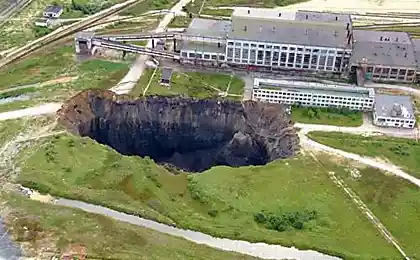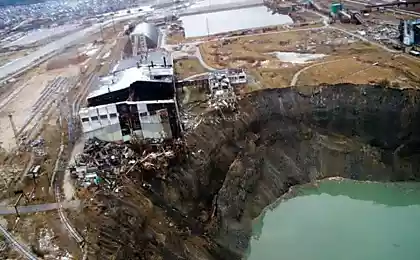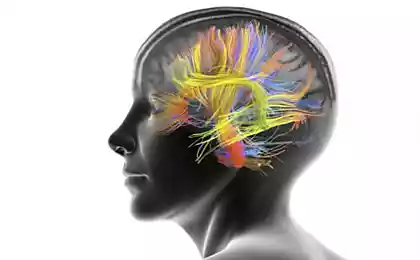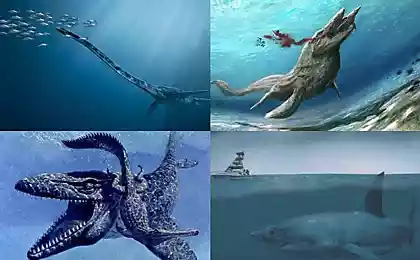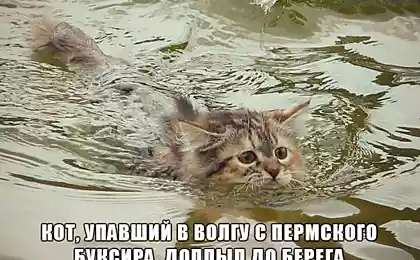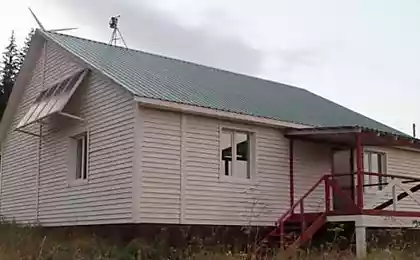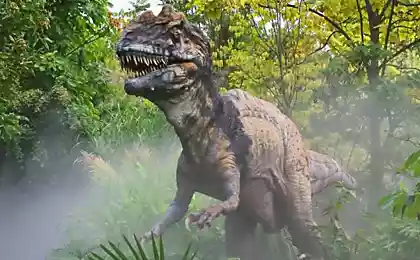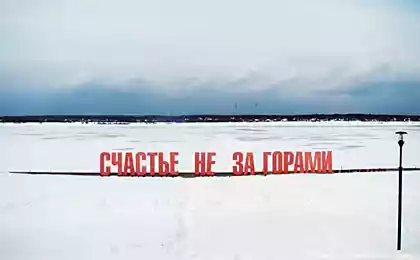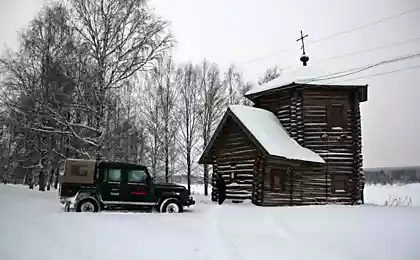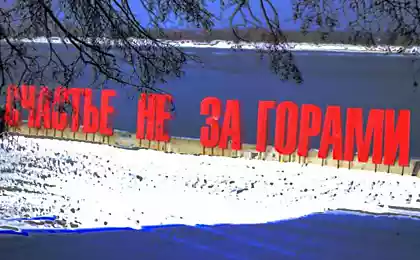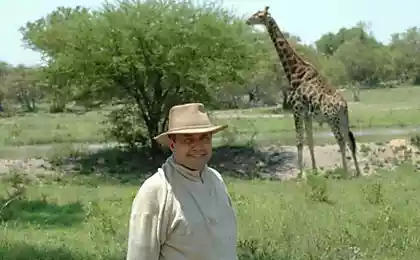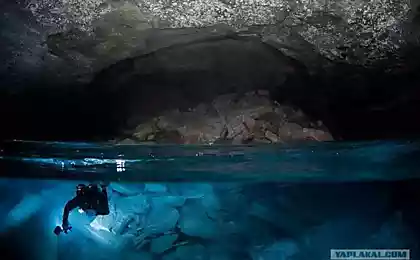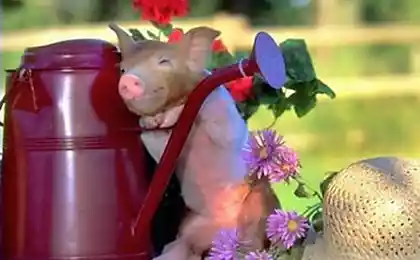1196
Small animals Permian
In the old days, when the metallurgical railway has not yet built, the most economical way to transport goods Uralsky Metallurgical Works was rafting on small cargo barges. "Pilots" of these barges sea in the eye had never seen, but during the rafting on the river have had a real chance to break the vessels of the most real reefs. That's like a rock Ermak on Sylva (above) - Reef ancient Permian Sea, however, is not the coral and mshankovy. It is a virtually complete stratigraphic section of the Permian period - that is, throughout this period, four and a half dozen million years, the colony of microscopic creatures, one of many, layer by layer grown under the waters of the Perm Sea. And on the shores of the Sea have lived various small animals.
For more information about the Permian catastrophe here
14 photos + text.
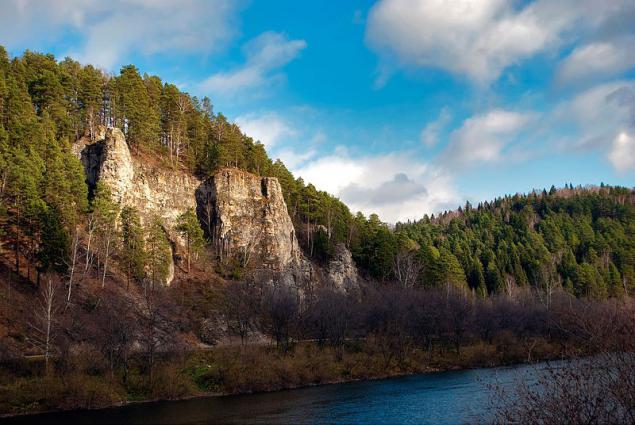
Latitudes are given with an accuracy of 5.10 degrees, longitude, are arbitrary; a significant difference in longitude.
MN - Mongolia;
PP - Russian Plain;
PIP - the Ural (Perm) Sea;
GLC - Kazakhstan;
NC - North China microcontinent, who had contact with Angarida;
UK - South China microcontinent.
The north and east were inhabited Angarida cold-water fauna and sometimes Coverage ice at the South Pole also be present this massive Antarctic glaciation.
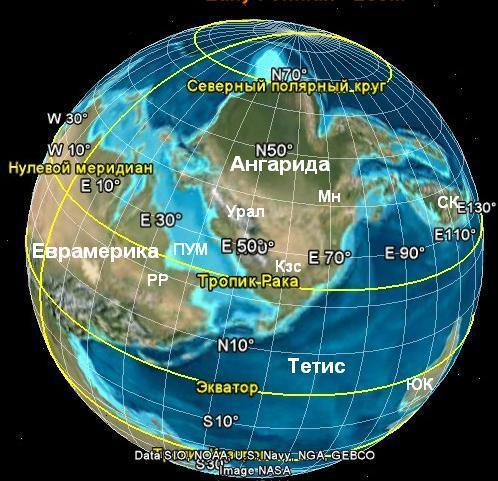
Heated in the sun decorated with Karen (Karenites ornamentatus) - insectivorous creature stuck in its structure somewhere between a ferret and a salamander. Forty centimeters in length, it is difficult to be more precise - it zhopku tail and was never found. It refers to therocephalia - a group of mammal-like, akin to the ancestors of mammals. The pits in his skull indicate the presence of a mustache, and those perhaps that he was hunting in the water, as well as the structure of its auditory system - it was easier to hear under water or pick up the vibrations of the soil, putting the lower jaw to the ground than to perceive sound waves in air. Perhaps the bargain to the whiskers, he was covered with short fur - probably originally had the role of fur skin protection Synapsid from rapid drying, and then, as the occurrence of warm-blooded, she took over the functions of heat preservation. On a ridge near karenita nedopantsir it came from a number of ossified scutes under the skin and around the edges of the brush - the rudiments of extra fingers, he inherited from our common ancestor with him, did not immediately determine the number of fingers. At the same time, Karen had a pretty good brain development, which distinguishes it from many other Permian creatures, such as his friend perpleksizavr (Perplexisaurus foveatus):
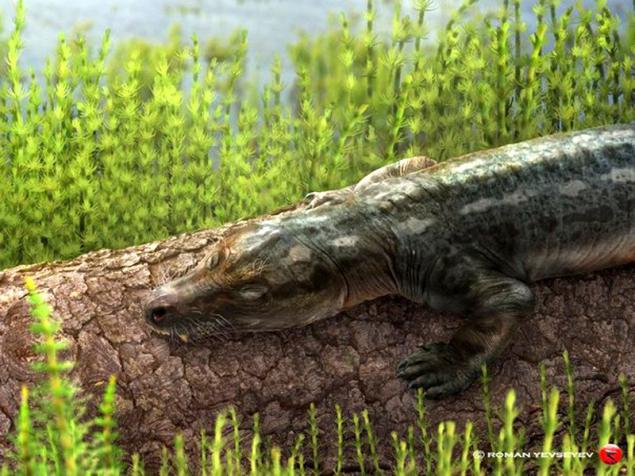
He was also terotsefal, one and a half times less karenita. A proburnetiya was a half times greater:
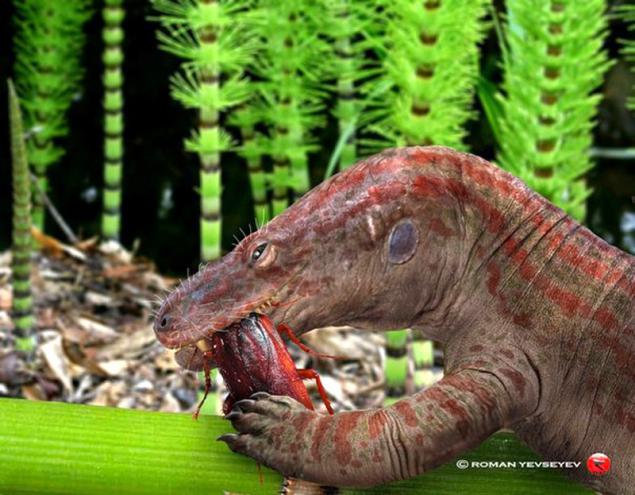
About proburnetiyu (Proburnetia viatkensis) very little that is known, from her one head left, with strange growths that resemble those of estemmenozuha. But what looks like a thicket of willows in the background, in fact growths pursongii, plants from the class of Ginkgo - in the Permian there were at least a dozen genera, of which up to now lived only one species - the actual ginkgo, and thanks to the participation of man - Japanese cherished relic tree and planted it beside the temple. In the Permian period on branches Ginkgoales often climbed Sumin (Suminia getmanovi):
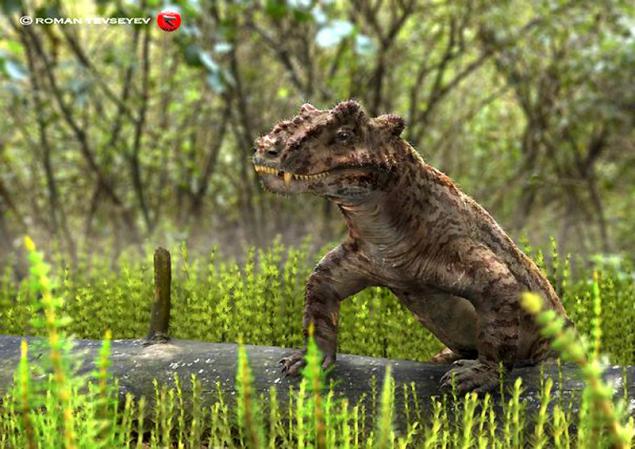
It is small - about half a meter in length - a graceful animal with a well-developed toes on the feet (one was opposed) and a long flexible tail resembled a cross between a monkey and lizards horses with protruding teeth. It consists in a detachment from the already mentioned me dicynodonts. Once able to find a whole slab of petrified sandstone, which was about twenty skeletons Sumin. Maybe they have lived in a group, and can be, the bodies were taken down stream from different places, for example, during the flood. Sumin able to chew - their jaws moving in multiple planes, and the wear of the teeth suggests that their food was coarse vegetation containing mineral crystals, such as horsetails. Sumin could climb trees, not only for food but also for the protection of large terrestrial predators. Although not always have time - evidenced by the broken bone Sumin found in petrified therocephalia litter of prey, such as vyatkozuh (Viatkosuchus sumini):
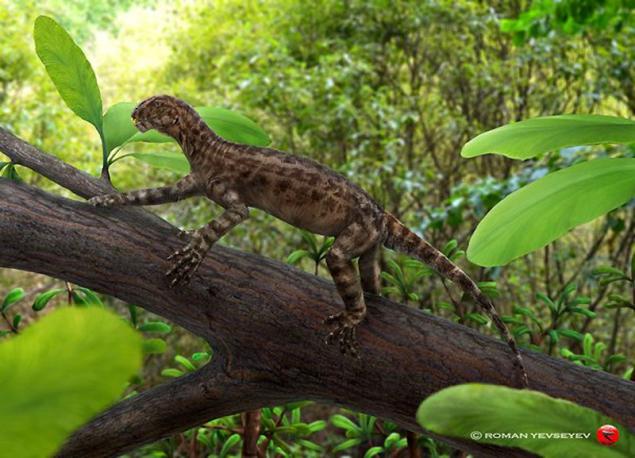
His limbs were short and, as in other mammal-like the time stuck to the side, that is, long-distance walker it was unimportant, but on the dash would be like modern monitor lizards, very swift. This allowed him to eat all of these animals, and not only them: the skeleton of a fossilized vyatkozuha undigested contents of the intestine in which the bones of the skull emeroletera (Emeroleter levis):
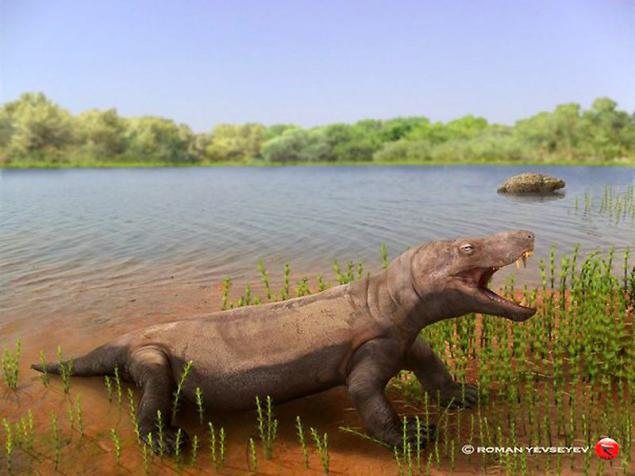
Previous beasts, though were like lizards treated in Synapsid, which include our ancestors Cynodont, but emeroleter, though more like a lizard belongs to anapsid and related more turtles. Brains, he had rather weak, but for some reason had been the third glazik and perfect ear allows him to listen to the buzzing of insects, concurring, whom he probably devoured. He lived near water, where grazing and much more impressive anapsid:
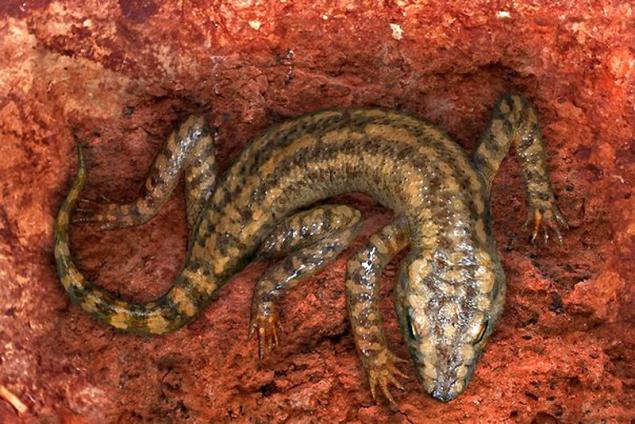
Pareiasaur (Deltavjatia vjatkensis top, Proelginia permiana below) - Heavy slow parareptilia size from a pig to a hippopotamus - probably looked like hippos and lifestyle. They probably ate soft water vegetation and grazing in ponds, but as exhaustion or drying "pastures" can travel long distances in search of new land. The maxillary teeth served them for cutting and obkusyvaniya succulent plant, but not for chewing: the role is located on the roof of the mouth small teeth that act as the grater.
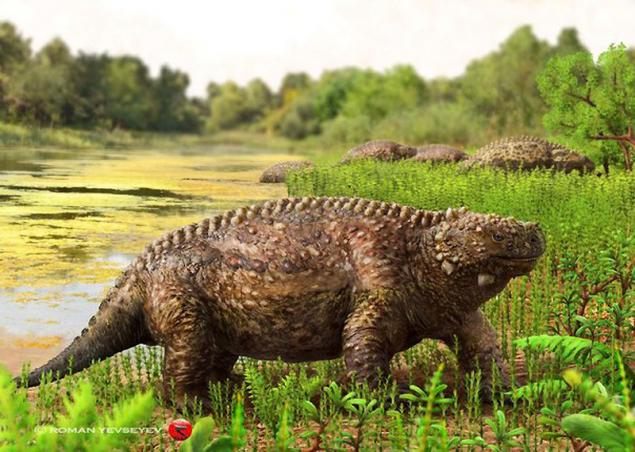
Spending a lot of time chewing pareiasaur could not afford - a complete partition between the nasal and oral cavities they did not have, so chew and swallow at the same time they could not - plucked, rubbed on the "float" and swallowed. Perhaps some helped the situation skin breath like a toad. According to some researchers they, like modern amphibians, had a throat pouch through which happened pushing air into the lungs. Well-developed voice sinuses in the skull pareiasaur suggests that dinosaurs could communicate with each other by means of powerful guttural sounds, for example, in the mating season. Under the soft glandular skin they have underlain osteoderms - some no protection from canines of saber-toothed gorgonopsia such as vyatkogorgon (Viatkogorgon ivachnenkoi):

Vyatkogorgon itself was small - a mongrel, but even Kotel'nich pareiasaur-deltavyatii were not with the size of a hippo, and a medium-sized hog. And for the penetration of their thick skins and vyatkogorgonu needed fangs:
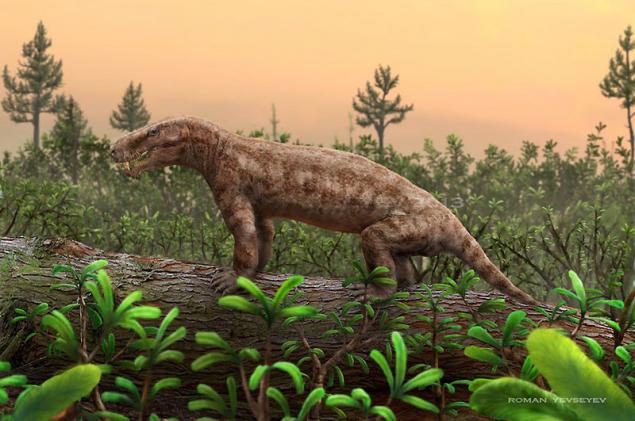
The most developed part of his brain was the cerebellum - This provides good coordination. The hind limbs could take rectified the situation, and, in recent years has shown the possibility of movement of the skeleton and straightening the front leg - probably vyatkogorgon and gather gorgonopsia were the fastest predators of their time. If pareiasaur could not fill up, vyatkogorgon could catch and Sumino or any avstralobarbara (Australobarbarus kotelnitshi):
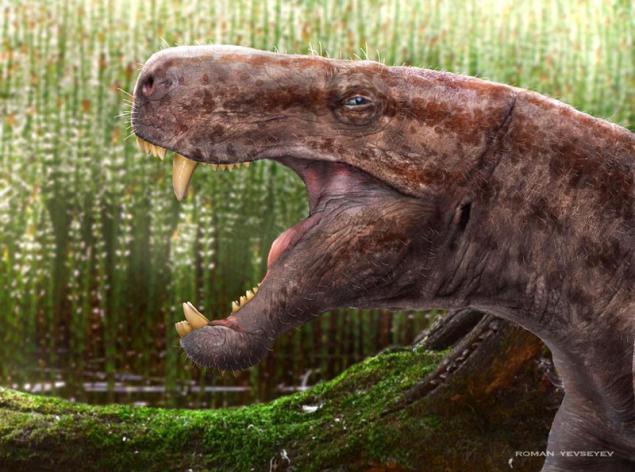
Avstralobarbar dicynodonts was primitive. Most of his relatives lived then south, in the part of Pangea that later became Africa, and it is here preferred to the Urals. Like other dicynodonts, he had both teeth and beak and legs, good adapted for digging.
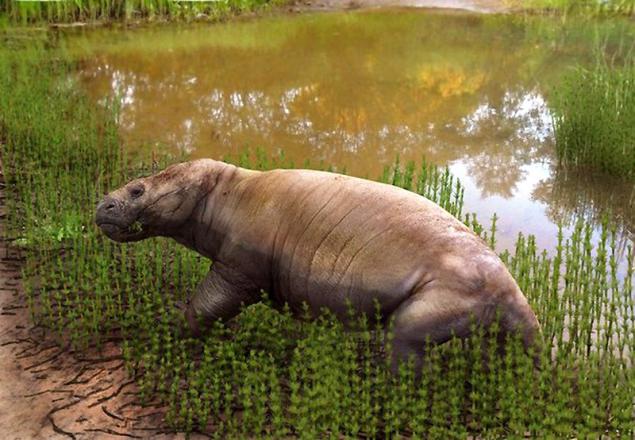
And all of these creatures were carrying eggs. Come join us in the Urals. Or in the Kirov region ...
All the little animals painted Roman Evseev
Scale table is drawn on the basis of pictures of Dmitry Bogdanov
via
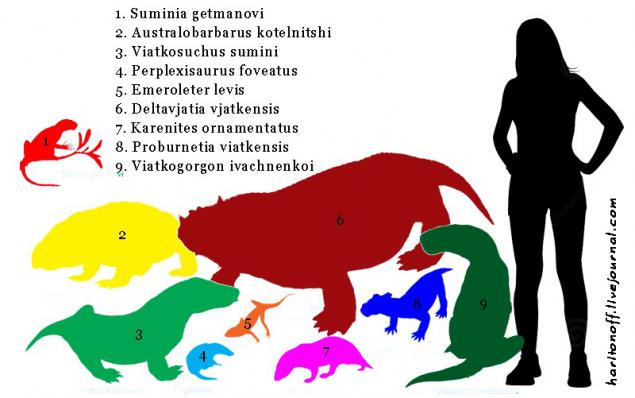
Source:
For more information about the Permian catastrophe here
14 photos + text.

Latitudes are given with an accuracy of 5.10 degrees, longitude, are arbitrary; a significant difference in longitude.
MN - Mongolia;
PP - Russian Plain;
PIP - the Ural (Perm) Sea;
GLC - Kazakhstan;
NC - North China microcontinent, who had contact with Angarida;
UK - South China microcontinent.
The north and east were inhabited Angarida cold-water fauna and sometimes Coverage ice at the South Pole also be present this massive Antarctic glaciation.

Heated in the sun decorated with Karen (Karenites ornamentatus) - insectivorous creature stuck in its structure somewhere between a ferret and a salamander. Forty centimeters in length, it is difficult to be more precise - it zhopku tail and was never found. It refers to therocephalia - a group of mammal-like, akin to the ancestors of mammals. The pits in his skull indicate the presence of a mustache, and those perhaps that he was hunting in the water, as well as the structure of its auditory system - it was easier to hear under water or pick up the vibrations of the soil, putting the lower jaw to the ground than to perceive sound waves in air. Perhaps the bargain to the whiskers, he was covered with short fur - probably originally had the role of fur skin protection Synapsid from rapid drying, and then, as the occurrence of warm-blooded, she took over the functions of heat preservation. On a ridge near karenita nedopantsir it came from a number of ossified scutes under the skin and around the edges of the brush - the rudiments of extra fingers, he inherited from our common ancestor with him, did not immediately determine the number of fingers. At the same time, Karen had a pretty good brain development, which distinguishes it from many other Permian creatures, such as his friend perpleksizavr (Perplexisaurus foveatus):

He was also terotsefal, one and a half times less karenita. A proburnetiya was a half times greater:

About proburnetiyu (Proburnetia viatkensis) very little that is known, from her one head left, with strange growths that resemble those of estemmenozuha. But what looks like a thicket of willows in the background, in fact growths pursongii, plants from the class of Ginkgo - in the Permian there were at least a dozen genera, of which up to now lived only one species - the actual ginkgo, and thanks to the participation of man - Japanese cherished relic tree and planted it beside the temple. In the Permian period on branches Ginkgoales often climbed Sumin (Suminia getmanovi):

It is small - about half a meter in length - a graceful animal with a well-developed toes on the feet (one was opposed) and a long flexible tail resembled a cross between a monkey and lizards horses with protruding teeth. It consists in a detachment from the already mentioned me dicynodonts. Once able to find a whole slab of petrified sandstone, which was about twenty skeletons Sumin. Maybe they have lived in a group, and can be, the bodies were taken down stream from different places, for example, during the flood. Sumin able to chew - their jaws moving in multiple planes, and the wear of the teeth suggests that their food was coarse vegetation containing mineral crystals, such as horsetails. Sumin could climb trees, not only for food but also for the protection of large terrestrial predators. Although not always have time - evidenced by the broken bone Sumin found in petrified therocephalia litter of prey, such as vyatkozuh (Viatkosuchus sumini):

His limbs were short and, as in other mammal-like the time stuck to the side, that is, long-distance walker it was unimportant, but on the dash would be like modern monitor lizards, very swift. This allowed him to eat all of these animals, and not only them: the skeleton of a fossilized vyatkozuha undigested contents of the intestine in which the bones of the skull emeroletera (Emeroleter levis):

Previous beasts, though were like lizards treated in Synapsid, which include our ancestors Cynodont, but emeroleter, though more like a lizard belongs to anapsid and related more turtles. Brains, he had rather weak, but for some reason had been the third glazik and perfect ear allows him to listen to the buzzing of insects, concurring, whom he probably devoured. He lived near water, where grazing and much more impressive anapsid:

Pareiasaur (Deltavjatia vjatkensis top, Proelginia permiana below) - Heavy slow parareptilia size from a pig to a hippopotamus - probably looked like hippos and lifestyle. They probably ate soft water vegetation and grazing in ponds, but as exhaustion or drying "pastures" can travel long distances in search of new land. The maxillary teeth served them for cutting and obkusyvaniya succulent plant, but not for chewing: the role is located on the roof of the mouth small teeth that act as the grater.

Spending a lot of time chewing pareiasaur could not afford - a complete partition between the nasal and oral cavities they did not have, so chew and swallow at the same time they could not - plucked, rubbed on the "float" and swallowed. Perhaps some helped the situation skin breath like a toad. According to some researchers they, like modern amphibians, had a throat pouch through which happened pushing air into the lungs. Well-developed voice sinuses in the skull pareiasaur suggests that dinosaurs could communicate with each other by means of powerful guttural sounds, for example, in the mating season. Under the soft glandular skin they have underlain osteoderms - some no protection from canines of saber-toothed gorgonopsia such as vyatkogorgon (Viatkogorgon ivachnenkoi):

Vyatkogorgon itself was small - a mongrel, but even Kotel'nich pareiasaur-deltavyatii were not with the size of a hippo, and a medium-sized hog. And for the penetration of their thick skins and vyatkogorgonu needed fangs:

The most developed part of his brain was the cerebellum - This provides good coordination. The hind limbs could take rectified the situation, and, in recent years has shown the possibility of movement of the skeleton and straightening the front leg - probably vyatkogorgon and gather gorgonopsia were the fastest predators of their time. If pareiasaur could not fill up, vyatkogorgon could catch and Sumino or any avstralobarbara (Australobarbarus kotelnitshi):

Avstralobarbar dicynodonts was primitive. Most of his relatives lived then south, in the part of Pangea that later became Africa, and it is here preferred to the Urals. Like other dicynodonts, he had both teeth and beak and legs, good adapted for digging.

And all of these creatures were carrying eggs. Come join us in the Urals. Or in the Kirov region ...
All the little animals painted Roman Evseev
Scale table is drawn on the basis of pictures of Dmitry Bogdanov
via

Source:
Span through the stone gates at a speed of 150 km /
The girl decided to experience the power of Mentos
